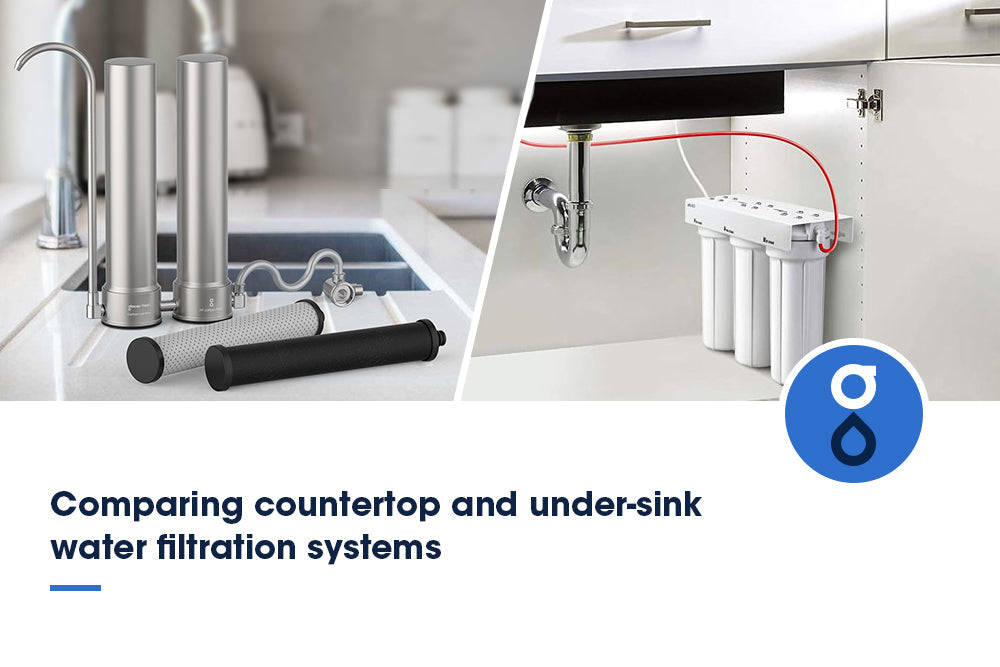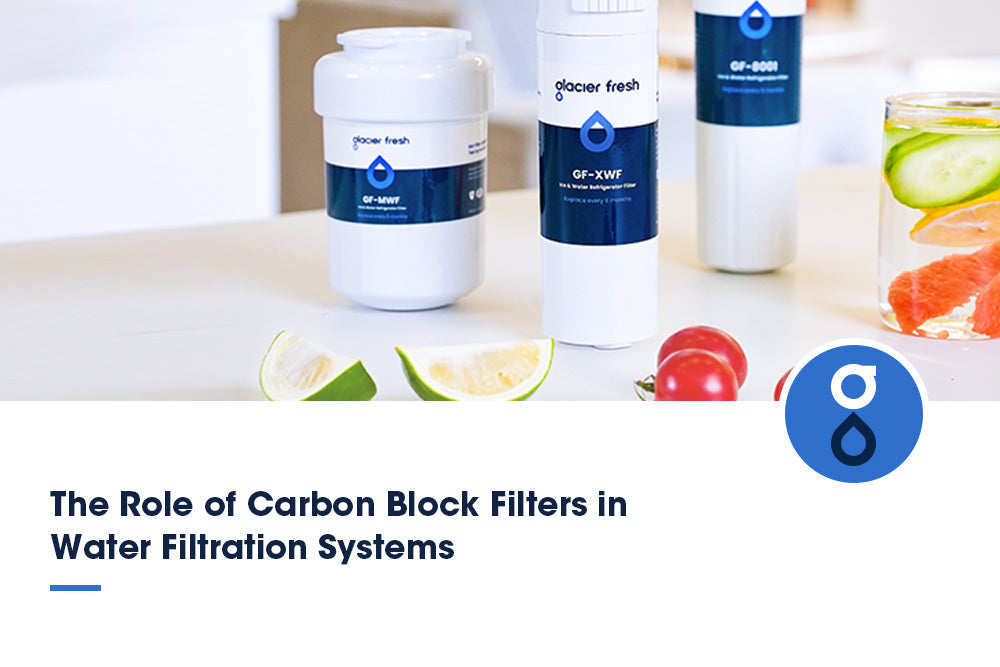Table of Contents:
All about countertop water filters
What you need to know about under-sink water filters
Pros and cons of countertop water filters
Pros and cons of under-sink water filters
Countertop VS under-sink water filter: the main differences
Countertop VS under-sink water filters: Who wins?
FAQs
Conclusion
You're on a mission to improve your home's water quality, but you're torn between a countertop and an under-sink water filtration system. It's a common dilemma. Both have their strengths and weaknesses, and it sometimes needs to be clarified which fits your needs best. Don't worry; this article is here to help. We'll delve into the intricacies of both options, comparing their pros and cons to help you make an informed decision. Whether it's a countertop model's convenience or an under-sink system's out-of-sight nature that appeals to you, we've got you covered. So, let's dive in and find the perfect filtration system for your home!
All about countertop water filters
What are countertop water filters?
A countertop water filter is a compact device on your kitchen counter and is designed to purify your tap water. It filters out contaminants from your water, resulting in improved taste and purity. Installing a countertop water filter is easy and requires no special tools or plumbing skills. Maintenance is also simple, as you must periodically replace the filter cartridge.
How do countertop water filters work?
So, you're probably wondering how these little wizards of hydration work. Well, it's less magic and more science. The water from your tap flows into the filter, where unwanted pollutants are trapped, and clean water is released through a different outlet. The complexity of filter maintenance varies with other models. Some require regular filter replacement, making them more high maintenance. Installation challenges can arise with some models, especially if your faucet needs to be compatible. But don't worry; most manufacturers provide adaptors for different faucet types. Cost comparison with under-sink filters may favor these countertop versions due to their relatively low upfront and maintenance costs.
Types of countertop water filters
Countertop water filters come in various types, offering a convenient and effective way to ensure clean and safe drinking water. There are three main types of countertop water filters: carbon filters, reverse osmosis systems, and ion exchange resin filters.
Carbon filters are the most common type of countertop water filter. They use activated carbon to remove impurities and improve the taste and odor of water. These filters work by trapping contaminants in the small spaces within the carbon block, effectively removing chlorine, sediments, and certain chemicals. Reverse osmosis systems are a more advanced filtration option. They use a multi-stage process to remove many impurities, including bacteria, viruses, heavy metals, and dissolved solids. Ion exchange resin filters are designed to remove specific contaminants, such as heavy metals and certain chemicals. While countertop water filters are adequate, water filter pitchers and faucet filters offer additional benefits. Water filter pitchers are portable and can be conveniently stored in the refrigerator.
What you need to know about under-sink water filters
What are under-sink water filters?
Undersink reverse osmosis systems are compact units installed directly into the water line beneath your kitchen sink. These systems provide a seamless way to purify your drinking and cooking water without wasting valuable countertop space. Filter installation is usually simple and can often be a DIY project for the handy homeowner. However, you will need to change the filter regularly. The filter lifespan varies depending on the model and your usage. It's important to remember that filter replacements can add to the overall maintenance costs over time. However, the assurance of clean, safe drinking water might make it worth your while.
How under-sink water filters work?
Curious about the inner workings of these compact purifiers? Let's peel back the layers and explore how under-sink filters operate to deliver pure, safe water straight from your tap.
Contaminants are captured and removed at the system's heart as water flows through the filtration stages. Due to their installation complexities, these units are usually tucked away beneath your sink. But don't fret; filter maintenance is a breeze despite their hidden location. Depending on the model and water usage, you replace the cartridges periodically. Cost comparisons vary, some under-sink filters might seem pricier than their countertop counterparts, but they often deliver superior filtration.
Pros and cons of countertop water filters
One of the biggest pros of countertop filters is their filter lifespan. Often, these models can filter several thousand gallons before requiring a replacement, making them a cost-effective choice in the long run. Plus, they're also known for their straightforward installation. You won't need a plumber or fancy tools to set it up, making the process hassle-free and even a little fun if you're a fan of DIY projects. However, countertop models do have their limitations. While filter replacements may not be frequent, they can be pricey regarding maintenance costs. Additionally, these systems occupy your counter, which may be better if you work with limited kitchen real estate.
Pros and cons of under-sink water filters
Under-sink water filters offer several advantages and disadvantages compared to other filtration systems. One of the main advantages of under-sink filters is their compact size, which allows them to be conveniently installed below the kitchen sink. This saves valuable countertop space, making under-sink filters a preferred choice for those with limited kitchen counter area.
Another advantage of under-sink filters is their ability to address complex water quality issues. These filters often consist of multiple stages of filtration, including sediment filters, carbon filters, and ion exchange resin. This multi-stage filtration process effectively removes harmful contaminants, bad taste, and odor from the water, providing clean and great-tasting water for drinking and cooking.
However, there are also some drawbacks to consider:
- Under-sink filters typically require professional installation, which can add to the overall cost.
- These filters are not portable and cannot be moved from one location to another, like countertop filters or water filter pitchers. Size and space limitations should be considered when choosing an under-sink water filter. Measuring the space below the sink is essential to ensure compatibility with the selected filter model.
- Consider the filter's capacity and maintenance requirements, including filter replacement and maintenance costs.
Countertop VS under-sink water filter: the main differences
Installation and space requirements
Regarding installation and space requirements, the countertop water filter is like a sleek, compact accessory on your kitchen counter, while the under-sink water filter is hidden away like a secret weapon, tucked neatly under your sink. The countertop filter is a stand-alone unit that can be easily installed without any plumbing modifications. It simply attaches to your existing faucet, making it a convenient option for those who want to avoid dealing with complex installations.
In terms of space, it takes up minimal counter space, allowing easy access to filtered water without sacrificing valuable working area. On the other hand, the under-sink water filter requires a bit more effort to install. It must be connected to your existing plumbing system, which may require professional assistance. However, once installed, it remains out of sight and doesn't take up any counter space, giving your kitchen a cleaner and more organized look.
Filtration capacity and efficiency
When comparing countertop and under-sink water filters, it is essential to consider their filtration capacity and efficiency. Countertop filters typically have a lower filtration capacity compared to under-sink filters. They are designed to filter a smaller volume of water at a time, making them suitable for individuals or small households. On the other hand, under-sink filters have a higher filtration capacity and can filter a larger volume of water. This makes them ideal for families or households with higher water consumption.
In terms of efficiency, under-sink filters often have multiple stages of filtration, including activated carbon and sediment filters, to remove various contaminants effectively. Countertop filters may have fewer filtration stages, which could affect their overall efficiency in removing impurities from the water.
Maintenance and filter replacement
Countertop water filters typically have a single filter cartridge that needs to be replaced every few months. The replacement process is usually simple and can be done by the user without any professional help. On the other hand, under-sink water filters often have multiple filter stages, which may require different types of cartridges.
Under-sink filters' maintenance and replacement process can be more complex and may require some technical knowledge. Additionally, under-sink filters are usually installed under the sink, which may make access and replacement more challenging compared to countertop filters.
Water flow and dispensing options
The water flow and dispensing options vary between the two filtration systems. Countertop water filters typically have a slower flow rate than under-sink filters. This is because countertop filters are usually gravity-fed and rely on the force of gravity to filter the water. On the other hand, under-sink filters are connected directly to the water supply and have a higher water flow rate.
This means that under-sink filters can provide a faster and more consistent flow of filtered water. Additionally, countertop filters usually have a single dispensing option and a separate faucet installed on the countertop. On the other hand, under-sink filters can be connected to the existing faucet, providing a more convenient and versatile dispensing option.
Cost and long-term investment
Save money in the long run by considering these filtration systems' cost and long-term investment. The price is an essential factor when comparing countertops and under-sink water filters. Countertop filters are generally more affordable upfront, ranging from $50 to $200. On the other hand, under-sink filters tend to be more expensive initially, starting from $200 and going up to $1000. However, looking beyond the initial cost and considering the long-term investment is essential.
Countertop filters usually require frequent replacements, which can add up over time. On the other hand, under-sink filters typically have longer-lasting filters that only need replacement every 6-12 months. Therefore, while under-sink filters may have a higher upfront cost, their long-term investment can be more cost-effective.
Countertop VS under-sink water filters: Who wins?
Ready to declare a victor in this face-off between two types of filters? It's more complex. Your choice between the countertop and under-sink water filters largely depends on your needs and circumstances. Regarding installation costs, under-sink filters often require professional help, which increases the initial expenses. On the other hand, countertop filters are typically easy to set up, saving you that extra cost. Now, let's talk about the maintenance frequency. Generally, countertop filters need more frequent replacements than their under-sink counterparts.
So, while they might be cheaper to install, they could cost you more in the long run. As for the filter lifespan, under-sink filters usually have a longer lifespan because of their larger size and capacity. This means less frequent replacements and potentially more savings over time. It all boils down to what suits you best. If you're after low, upfront costs and ease of installation, a countertop filter might be the winner. But if you prefer a longer lifespan and less frequent maintenance, the under-sink filter could take the crown. It's your call; choose wisely.
FAQs
Can countertop and under-sink filters be used with other water purification methods?
Yes, both countertop and under-sink filters can be used with other purification methods. Consider filter compatibility, cost comparison, and environmental impact when combining different water purification systems to achieve optimal results.
What are some standard maintenance and troubleshooting tips for both types of filters?
Regularly replace filters based on the manufacturer's guidelines. Keep them clean by following the cleaning procedures provided. Use the troubleshooting guide for any issues. Remember, maintenance is critical to optimal performance.
Are there any health risks associated with using either of these water filtration systems?
No, there aren't any significant health risks. However, filter-related illnesses can occur if filters aren't appropriately changed. Material toxicity is rare but possible. Also, bacterial contamination can happen with improper maintenance.
Conclusion
In the end, it's all about your needs and preferences. A countertop water filter is your best bet if you prioritize convenience and portability. If you desire a more robust filtration and don't mind the installation, go for an under-sink model. Remember, ensuring you and your family have access to clean, safe water is essential.




















